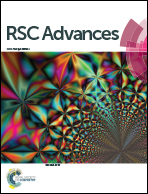Cesium selective polymeric membrane sensor based on p-isopropylcalix[6]arene and its application in environmental samples
Abstract
The present work deals with developing a highly selective membrane electrode based on p-isopropylcalix[6]arene for accurate determination of trace amounts of cesium cations. The amounts of ionophore (5 mg), PVC (30 mg), dioctyl phthalate (DOP) as a plasticizer (62 mg) and potassium tetrakis(4-chlorophenyl)borate (KTpClPB) as an ionic additive (3 mg) were optimized in the preparation of the membrane. The effects of various parameters such as pH, composition of the membrane, different cation interferences and concentration of internal solution were investigated. The electrode exhibited a linear response with a near Nernstian slope of 57.29 ± 0.31 (mV per decade of activity) over the pH range from 2 to 11 with a satisfactory concentration range of 1.0 × 10−6 to 1.0 × 10−1 M. The value of 1.0 × 10−6 M was obtained as a lower detection limit for the fabricated cesium-selective electrode. The developed sensor exhibited a good reproducibility over a period of about 12 weeks with a fast response time of less than 10 seconds. The proposed sensor was successfully applied as an indicator electrode for the potentiometric titration of a cesium solution with EDTA. The validation of the developed electrode was done using an inductively coupled plasma technique (ICP) which confirmed the accuracy and precision of the fabricated electrode in the successful determination of cesium trace amounts in the environmental samples.
![Graphical abstract: Cesium selective polymeric membrane sensor based on p-isopropylcalix[6]arene and its application in environmental samples](/en/Image/Get?imageInfo.ImageType=GA&imageInfo.ImageIdentifier.ManuscriptID=C5RA02799C&imageInfo.ImageIdentifier.Year=2015)


 Please wait while we load your content...
Please wait while we load your content...